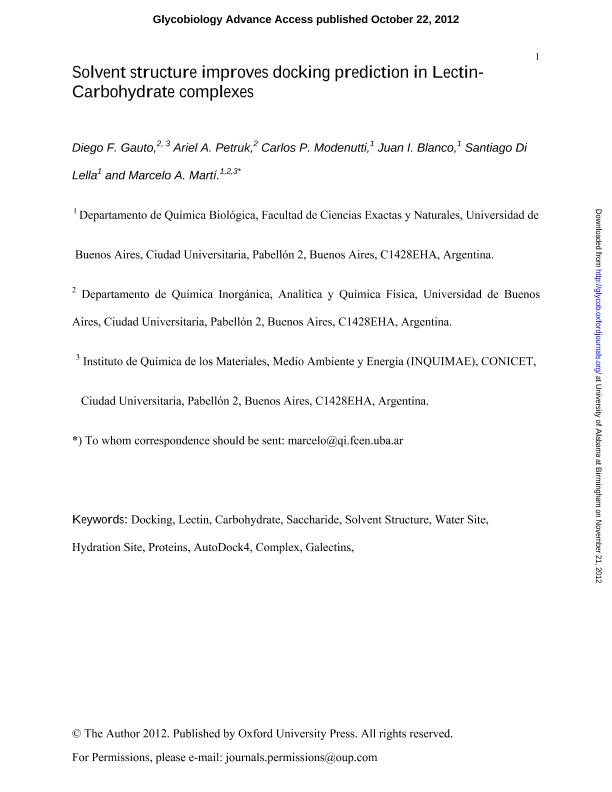Mostrar el registro sencillo del ítem
dc.contributor.author
Gauto, Diego Fernando

dc.contributor.author
Petruk, Ariel Alcides

dc.contributor.author
Modenutti, Carlos Pablo

dc.contributor.author
Blanco Capurro, Juan Ignacio

dc.contributor.author
Di Lella, Santiago

dc.contributor.author
Marti, Marcelo Adrian

dc.date.available
2019-02-26T17:28:49Z
dc.date.issued
2013-02
dc.identifier.citation
Gauto, Diego Fernando; Petruk, Ariel Alcides; Modenutti, Carlos Pablo; Blanco Capurro, Juan Ignacio; Di Lella, Santiago; et al.; Solvent structure improves docking prediction in lectin-carbohydrate complexes; Oxford University Press; Glycobiology; 23; 2; 2-2013; 241-258
dc.identifier.issn
0959-6658
dc.identifier.uri
http://hdl.handle.net/11336/70855
dc.description.abstract
Recognition and complex formation between proteins and carbohydrates is a key issue in many important biological processes. Determination of the three-dimensional structure of such complexes is thus most relevant, but particularly challenging because of their usually low binding affinity. In silico docking methods have a long-standing tradition in predicting protein-ligand complexes, and allow a potentially fast exploration of a number of possible protein-carbohydrate complex structures. However, determining which of these predicted complexes represents the correct structure is not always straightforward.In this work, we present a modification of the scoring function provided by AutoDock4, a widely used docking software, on the basis of analysis of the solvent structure adjacent to the protein surface, as derived from molecular dynamics simulations, that allows the definition and characterization of regions with higher water occupancy than the bulk solvent, called water sites. They mimic the interaction held between the carbohydrate-OH groups and the protein. We used this information for an improved docking method in relation to its capacity to correctly predict the protein-carbohydrate complexes for a number of tested proteins, whose ligands range in size from mono-to tetrasaccharide. Our results show that the presented method significantly improves the docking predictions. The resulting solvent-structure-biased docking protocol, therefore, appears as a powerful tool for the design and optimization of development of glycomimetic drugs, while providing new insights into protein-carbohydrate interactions. Moreover, the achieved improvement also underscores the relevance of the solvent structure to the protein carbohydrate recognition process.
dc.format
application/pdf
dc.language.iso
eng
dc.publisher
Oxford University Press

dc.rights
info:eu-repo/semantics/openAccess
dc.rights.uri
https://creativecommons.org/licenses/by-nc-sa/2.5/ar/
dc.subject
Autodock4
dc.subject
Carbohydrate
dc.subject
Complex
dc.subject
Docking
dc.subject
Galectins
dc.subject
Hydration Site
dc.subject
Lectin
dc.subject
Proteins
dc.subject
Saccharide
dc.subject
Solvent Structure
dc.subject
Water Site
dc.subject.classification
Otras Ciencias Biológicas

dc.subject.classification
Ciencias Biológicas

dc.subject.classification
CIENCIAS NATURALES Y EXACTAS

dc.title
Solvent structure improves docking prediction in lectin-carbohydrate complexes
dc.type
info:eu-repo/semantics/article
dc.type
info:ar-repo/semantics/artículo
dc.type
info:eu-repo/semantics/publishedVersion
dc.date.updated
2019-01-02T19:11:39Z
dc.journal.volume
23
dc.journal.number
2
dc.journal.pagination
241-258
dc.journal.pais
Reino Unido

dc.journal.ciudad
Oxford
dc.description.fil
Fil: Gauto, Diego Fernando. Consejo Nacional de Investigaciones Científicas y Técnicas. Oficina de Coordinación Administrativa Ciudad Universitaria. Instituto de Química, Física de los Materiales, Medioambiente y Energía. Universidad de Buenos Aires. Facultad de Ciencias Exactas y Naturales. Instituto de Química, Física de los Materiales, Medioambiente y Energía; Argentina
dc.description.fil
Fil: Petruk, Ariel Alcides. Universidad de Buenos Aires. Facultad de Ciencias Exactas y Naturales. Departamento de Química Inorgánica, Analítica y Química Física; Argentina. Consejo Nacional de Investigaciones Científicas y Técnicas; Argentina
dc.description.fil
Fil: Modenutti, Carlos Pablo. Universidad de Buenos Aires. Facultad de Ciencias Exactas y Naturales. Departamento de Química Biológica; Argentina. Consejo Nacional de Investigaciones Científicas y Técnicas; Argentina
dc.description.fil
Fil: Blanco Capurro, Juan Ignacio. Universidad de Buenos Aires. Facultad de Ciencias Exactas y Naturales. Departamento de Química Biológica; Argentina. Consejo Nacional de Investigaciones Científicas y Técnicas; Argentina
dc.description.fil
Fil: Di Lella, Santiago. Universidad de Buenos Aires. Facultad de Ciencias Exactas y Naturales. Departamento de Química Biológica; Argentina. Consejo Nacional de Investigaciones Científicas y Técnicas; Argentina
dc.description.fil
Fil: Marti, Marcelo Adrian. Consejo Nacional de Investigaciones Científicas y Técnicas. Oficina de Coordinación Administrativa Ciudad Universitaria. Instituto de Química, Física de los Materiales, Medioambiente y Energía. Universidad de Buenos Aires. Facultad de Ciencias Exactas y Naturales. Instituto de Química, Física de los Materiales, Medioambiente y Energía; Argentina
dc.journal.title
Glycobiology

dc.relation.alternativeid
info:eu-repo/semantics/altIdentifier/url/https://academic.oup.com/glycob/article/23/2/241/1988400
dc.relation.alternativeid
info:eu-repo/semantics/altIdentifier/doi/http://dx.doi.org/10.1093/glycob/cws147
Archivos asociados
